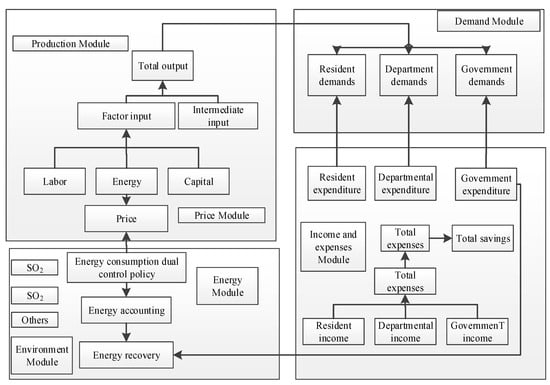4.1. Policy Scenario Setting
In this study, we analyze the situation of “resource curse” areas and set up energy consumption “dual control” policy scenarios. The base time of the model is set, and the software is considered. Based on economy, resource and environmental systems, initial policy scenario setting is set accordingly.
- (1)
The “resource curse” regional division of China
The “resource curse” coefficient is adopted to measure the “resource curse” in China, and the formula is as follows:
where is the “resource curse” coefficient, is energy, is gross domestic product.
When the “resource curse” coefficient is greater than 1, it indicates that the relevant area is cursed. The larger the value is, the greater the deviation between energy and economic growth appears. To distinguish the different situations of “resource curse” in China, each province is divided into three conditions, including high, low and no “resource curse”, as shown in
Table 3.
According to the “resource curse” coefficient, three different regions, (0,1), (1,3) and (3,+), are divided. Among them, the regions including Shanghai and others belong to the no “resource curse” regions. Regions such as Henan and others belong to low “resource curse” regions, indicating economic growth is slightly lower than energy endowment conditions, and energy advantages cannot be fully converted into economic growth. The economic growth of regions including Xinjiang and others lags far behind energy endowment, as the “resource curse” mostly occurs in central and western regions.
- (2)
Energy consumption “dual control” policy scenarios
The energy consumption “dual control” policy plays an important role in regulating energy use to achieve the binding and expected indicators of environmental protection. The reduction in energy consumption intensity is used as a binding index, and the total energy consumption management has certain flexibility. In this study, the energy output rate is selected to reflect the change in energy consumption intensity, and the total energy consumption management takes the total energy consumption as the goal.
In the dynamic CGE model, the specific policy scenario is set as the energy consumption per unit of GDP as the energy intensity control indicator and the per capita energy consumption upper limit standard as the energy intensity control. Based on the “14th Five-Year Plan”, regional energy total control and energy consumption intensity control standards are shown in
Table 4.
The base time of the model is 2020. Because the CGE model has good mid- and long-term simulation characteristics, the simulation period is set from 2025 to 2035, and the GAMS is adopted to simulate the impacts on the economy, resource and environmental systems.
- (3)
Initial policy scenario setting
In the initial setting of the economic system, the 2007–2020 GDP growth rate and other indicators are used to describe the economic development, as shown in
Table 5.
In the initial setting of the energy system, the average trend of energy production and consumption is obtained through historical data analysis. From 2007 to 2019, China’s energy production and consumption are shown in
Table 6.
The environmental system is represented by indicators, such as wastewater, waste gas and industrial solid waste; the discharge status of major pollutants is judged based on the average annual growth, among which the discharge of wastewater, waste gas and solid industrial waste is increased by an average annual rate of 0.2%, 6.5% and 7.9%. The funds used for pollution control increased at a rate of 8.6%, as shown in
Table 7.
4.2. The Simulated Results by Energy Consumption “Dual Control” Policy
- (1)
Impacts on elasticity of substitution and energy supply and demand
The impact of the energy consumption “dual control” policy on energy is reflected in the changes in the elasticity of energy substitution, energy consumption, and the relationship between the supply and demand of factors. The energy consumption “dual control” policy changes the substitution elasticity among several types of energy, thereby affecting the long-term trend of the change in the energy demand–supply relationship. The changes in the substitution elasticity among different energy sources are shown in
Table 8.
It can be seen that the substitution elasticity between coal and oil does not change greatly, while the substitution relationship among coal, oil and clean energy gradually increases, and coal clean energy decreases from 1.6166 in 2025 to 1.6122 in 2035. From 1.5326 in 2025 to 1.5286 in 2035, the energy consumption “dual control” policy has a positive effect on accelerating energy substitutions.
The detailed policies on regional energy consumption vary greatly. Compared with the total energy control, the impact of energy intensity control on regional energy consumption is greater and has more obvious changes in the ratio of energy supply and demand, as shown in
Figure 2.
Overall, the energy consumption “dual control” policy has a more obvious effect on energy consumption in the areas with no and low “resource curse”. From 2025 to 2035, energy consumption in areas without the “resource curse” will drop by 4.36% and 4.96%, respectively, and energy consumption in areas with high “resource curse” will drop by 1.57% and 1.98%, respectively. The decline in energy consumption in different regions under the control of energy intensity gradually decreased, and the cyclical fluctuation of energy consumption under the control policy of energy intensity decreased, which may be related to the political cycle of Chinese officials. The specific results are shown in
Table 9.
While the energy consumption “dual control” policy affects the proportion of energy supply and demand, the crowding-out effect of energy on factors such as capital and labor is gradually weakening. When the energy consumption intensity is controlled, the supply-and-demand ratio of capital elements in high “resource curse” areas increases from 80.15% in 2025 to 82.71% in 2035; when the total amount of energy is controlled, the capital element in the high “resource curse” area and the ratio of supply and demand increased by 7.60%, which means that after the implementation of the “dual control” policy, the role of energy input has begun to weaken, the input of capital elements has increased, and the energy consumption of the “dual control” policy has suppressed the crowding-out effect of capital, as shown in
Table 10:
The impact of the energy consumption “dual control” policy on the supply-and-demand ratio of human capital factors is shown in
Figure 3.
The energy consumption “dual control” policy obviously changed the supply-and-demand ratio of human elements. It is worth mentioning that in the areas without “resource curse”, the ratio of supply and demand of human capital elements varies greatly. The reason may be that the areas without “resource curse”, such as Jiangsu, Shanghai and Zhejiang, are mostly economically developed areas, which are more dependent on energy inputs. The control of energy consumption intensity effectively inhibits the development of high-energy-consuming industries, accelerates the process of industrial restructuring, and further increases the adjustment of the supply-and-demand ratio of human elements.
- (2)
Impact on regional economic development
The impacts of the GDP growth rate are different in various regions through the energy consumption “dual control” policy. The key indicators such as GDP growth rate, total output and total investment will decline to some degree. The energy consumption “dual control” policy has greater impacts in no and low “resource curse” regions than high “resource curse” regions. In regions without the “resource curse”, GDP growth will drop by 1.15% and 0.88%, respectively, from 2025 to 2035. The total output and total investment will be affected more obviously, and the growth rate will be reduced. From 2025 to 2035, total output will drop by 2.26% and 1.56%, respectively; total investment will drop by 2.01% and 1.78%, respectively. Because the no “resource curse” regions are distributed in the central and eastern regions, which is developed and the demand for energy is large, the energy endowment of the relevant regions is limited, and it needs to be transferred from other regions.
In high “resource curse” regions, the relevant area has little energy demand, and the energy endowment is superior, which belongs to the energy output area. The total output is less affected by the energy consumption “dual control” policy. The GDP growth rate will be from 2025 to 2025. In 2035, it will increase by 0.69% and 0.42%, respectively, and the total investment will increase by 0.56% and 0.27%, respectively, from 2025 to 2035. The impacts of the energy consumption “dual control” policy on economic development are shown in
Table 11.
Taken together, the energy consumption “dual control” policy has suppressed GDP growth and total output. The increase in the cost of energy use leads to lower profit margins and lowers the aggregate demand for consumption. Therefore, the energy consumption “dual control” policy has a significant impact on the growth rate of production and CDP. Since GDP is affected by a combination of factors such as investment, consumption, and import and export, the key indicators such as total output and total investment have fallen sharply, but the impact on long-term GDP growth has gradually weakened.
In detail, the impact of total energy control on the regional economy is smaller than that of the energy consumption intensity control. When energy consumption intensity control is adopted, indicators such as GDP growth rate and total consumption in no “resource curse” areas are less affected. The GDP growth rate will drop by −1.2553% and −0.9712%, respectively, from 2025 to 2035, but the indicators in the high “resource curse” region benefit from the dual control policy, and the GDP growth rate will increase by 0.7762% and 0.5427%, respectively, from 2025 to 2035.
Meanwhile, the impact of the energy consumption “dual control” policy on regional economic growth is quite different. The GDP growth of Shanghai, Jiangsu, Zhejiang, Shandong and Guangdong and other provinces has been significantly affected, and the GDP of some provinces has changed, as shown in
Table 12.
In regions, such as Jiangsu, Shanghai, Zhejiang and Guangdong, the demand for energy is stronger, and the “dual control” policy of energy consumption has a negative impact on economic development, resulting in a decline in GDP growth.
- (3)
Impact on environmental pollution
The energy consumption “dual control” policy has a significant inhibitory effect on the discharge of major pollutants. By 2035, the discharge of wastewater, SO
2, CO
2 and industrial solid waste will be reduced by more than 5%, as shown in
Table 13.
The energy consumption “dual control” policy changes the substitution relationship between different energy sources and reduces the dependence of economic development on energy. At the same time, due to the improvements in energy utilization efficiency, it increases the utilization of emission reduction technologies and reduces CO2 emissions.
Affected by the energy consumption “dual control” policy, carbon emissions in different regions will decrease, as shown in
Figure 4. Among them, the carbon emissions in low “resource curse” regions have the greatest decline, while in high “resource curse” regions, the “dual control” policy is conducive to regulating the energy consumption behavior, promote producers to focus on resource conservation, and reduce the discharge of major pollutants.
- (4)
Changes in regional “Resource Curse”
The energy consumption “dual control” policy directly regulates the relationship between energy supply and demand, which, in turn, affects the mode of economic growth and changes the regional “resource curse” coefficient. The area of “resource curse” has dropped significantly. The coefficient of “resource curse” in Anhui and Chongqing has changed from greater than 1 to less than 1, and the coefficient of “resource curse” has changed from greater than 1 to less than 1 in Jilin and Ningxia. The “dual control” policy has effectively alleviated the current dilemma of China’s regional “resource curse”. The changes in the regional “resource curse” coefficient (2035) are shown in
Table 14.


